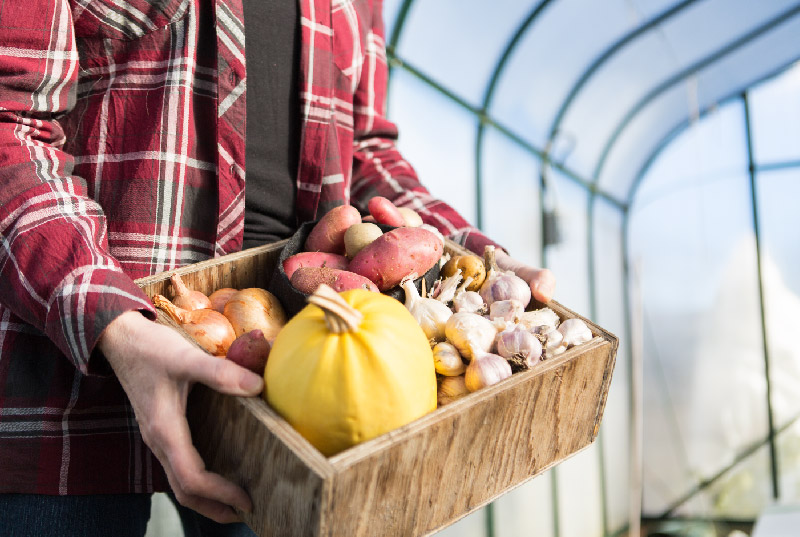
I help gardeners grow
& beginners blossom.
No seed left behind,
no soil unturned.
Together we can have lots of fun growing
great gardens using simple practical tips.
- Featured in -





Start saving & storing your garden seeds for a more more sustainable future
SIGN UP to get the FREE Seed packet PDF
X CLOSE
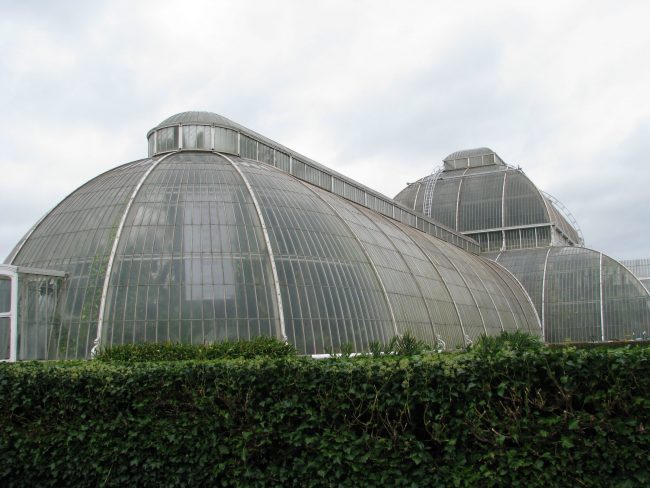
Greenhouse Tips and Tricks: Get the best Advice Here
“We’ve been around for a long time. So for us repeat businesses is when someone’s child comes to us 20 years after their parent bought a greenhouse and buys [their own] greenhouse.”
Kyle Exner is General Manager of BC Greenhouse Builders, a company that sells home and corporate greenhouses internationally. We had a good chat via podcast recently and this Blog post is a synopsis of that chat. Listen to the full interview HERE.
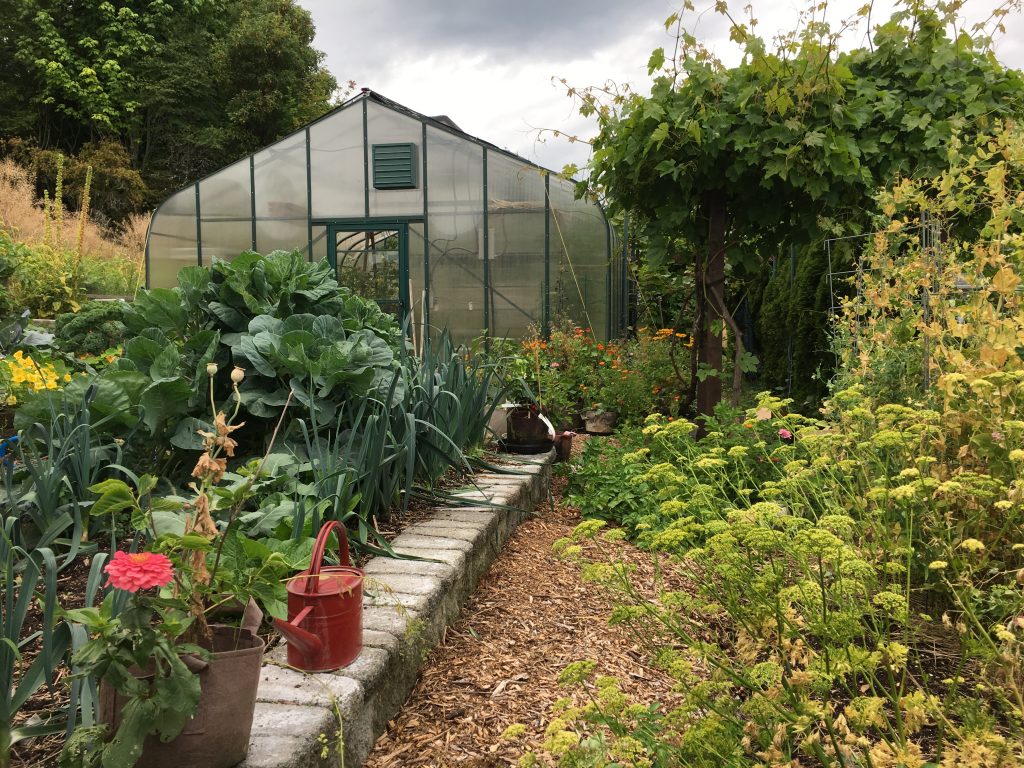
My big BC greenhouse is a Pacific series and is advertised for gardeners “on a budget” because it is the cheapest price per square foot. At 16′ x 20′ I have a lot on the go in here year round.

My friend Kathy Zip poses in her home-made wood greenhouse which is obviously cheaper construction than my tightly sealed BC Greenhouse Builders Pacific model. It works for Kathy because she is in a mild climate and mostly uses it as a Hoop House to keep out the rain. Recently Kathy planted peaches in her big wood-frame greenhouse to keep moisture off the plants and boost the heat for faster ripening. Wood has it’s benefits and certainly it used to be the go-to material for greenhouse building but not any more.
Exner loves it when people slap together some two by fours and put some plastic sheeting over top. “That is a great gateway into greenhouse gardening. But it’s, you know, a bit of a cold frame.
Full disclosure, I purchased two BC Greenhouse Builders greenhouses and I show off my greenhouses and plants online whenever I get a chance. I have had the greenhouses for 8 and 15 years and for three years I have been the Brand Ambassador for BC Greenhouse Builders so the two events are unrelated. I bought these greenhouses because they were the best for me at the time and they still are.
XXXXXXX
Wood seems like the original building material for greenhouses but by the mid-1950’s BC Greenhouse Builders stopped using wood as framing because it degrades over time.
Today’s aluminum frames don’t shift, swell, shrink or degrade the way wood does.
Exner, who has been with BC Greenhouse Builders 23 years started off as the office guy in what was a a much smaller company. “And now we have close to 45 people in the company and I’ve been around long enough, so I guess that’s why I get to be general manager,” says Exner when we chat in March.
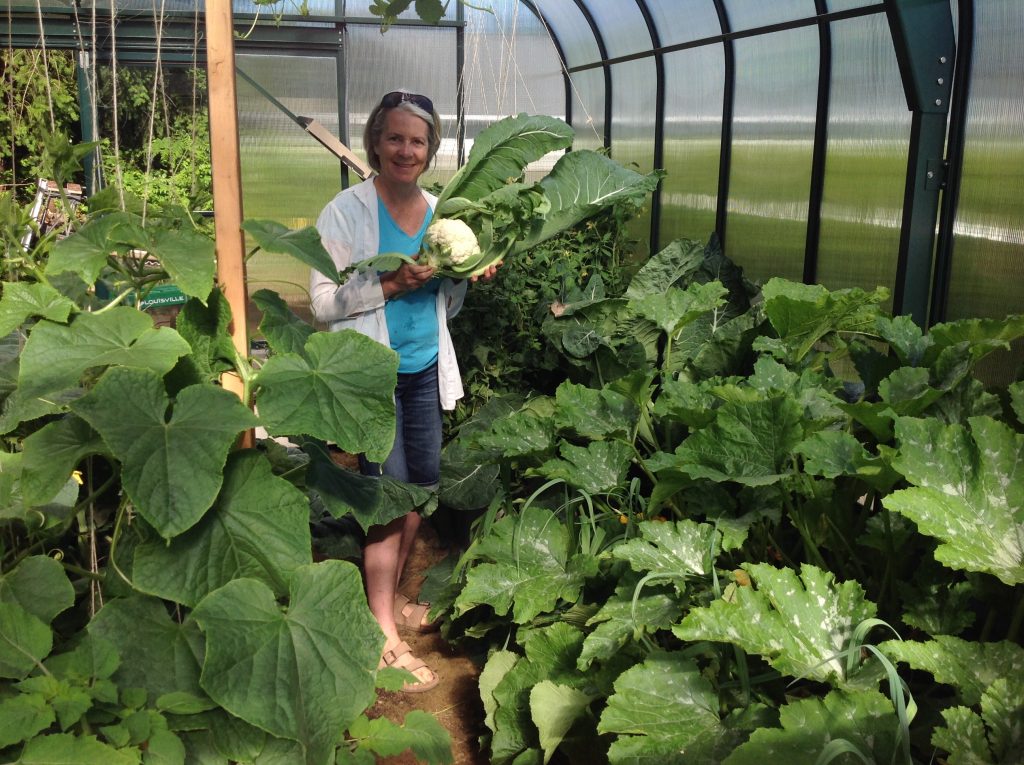
I have a greenhouse because it lets me boost my season beyond what I can grow outside. Cauliflowers early in the season or zucchini ready way before anything is possible outside.
I am a garden geek so having a greenhouse was a dream come true for me, but generally speaking greenhouses can be pricey so I ask Kyle why people even bother buying one.
“Oh, well, that’s an easy question for us. The best reason to buy a greenhouse really is that it lets gardeners expand their gardening further into the year. So whether it’s year round or just gaining extra time in the seasons, in the early spring and the late fall, I would say that’s the number one best reason or biggest reason to get a greenhouse.
And then the second reason is for people that want to do things in a greenhouse that they can’t do outside of the greenhouse. So it’s really popular to do hothouse tomatoes in in a greenhouse, because when the rains come, you’re not going to get blight inside your greenhouse.”
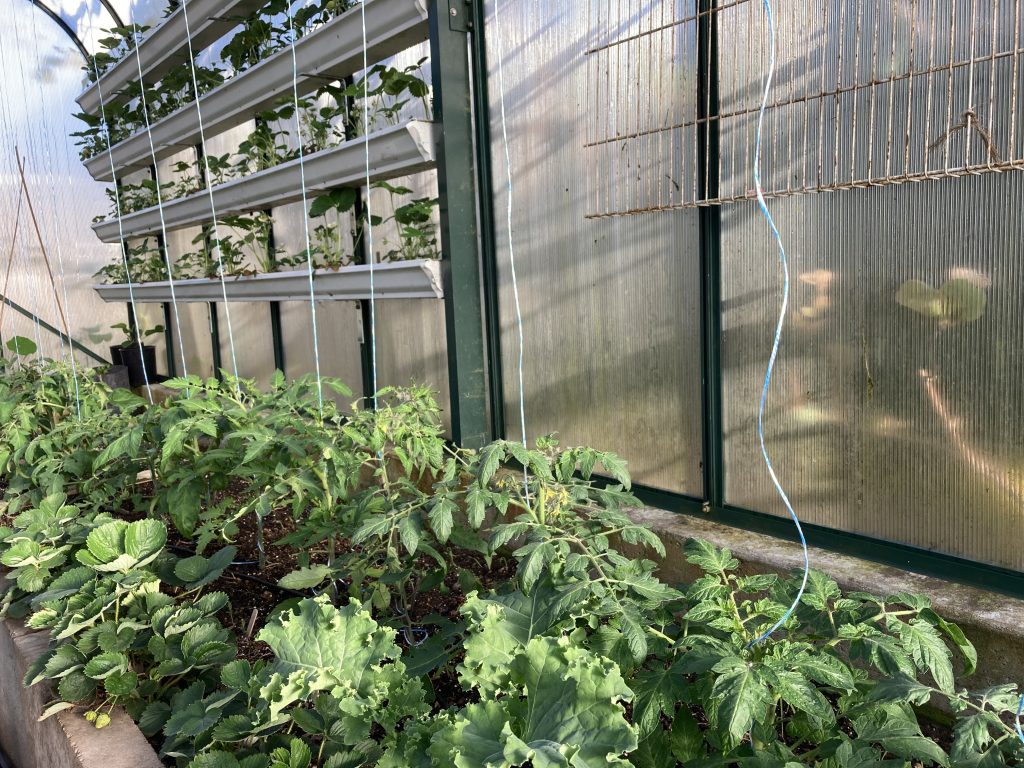
Early spring in the greenhouse is completely different than early spring outdoors where late frosts or snow prevent you from getting heat-loving plants like tomatoes and strawberries started early. This photo was taken May 1 from tomatoes planted in mid-April and strawberries in rain gutters now in full bloom.
But of course there is a wide price difference between a proper greenhouse and flimsy poly over a wood frame structure easily put together on a weekend. Kyle says that he loves when people are starting out and they slap together some two by fours and put some plastic sheeting over top. “That is a great gateway into greenhouse gardening. But it’s, you know, a bit of a cold frame.
One of the things I say is we may not be a person’s first green house, but we probably be their last greenhouse. When you start out you might buy something a bit more easy on the budget, but also, you know, entry-level. Our greenhouses will set themselves apart. They’re going to be stronger, so better for high winds, high snows. That’s what we care about as a builder.”
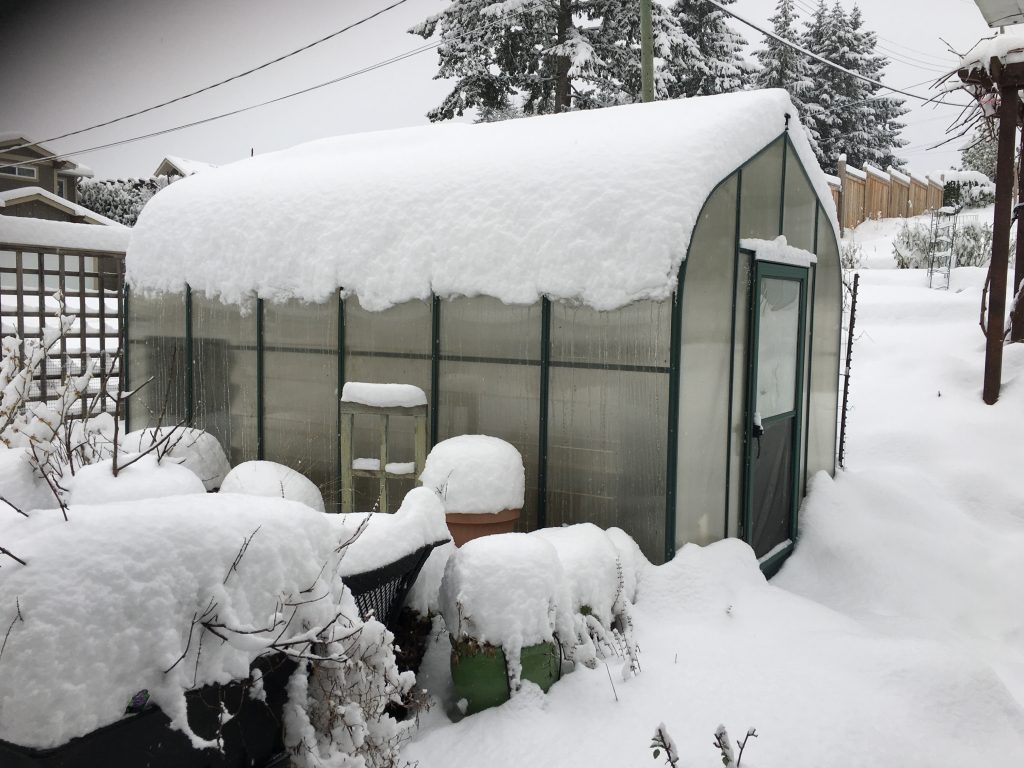
Heavy loads of snow, wind and icy conditions will not harm the super sturdy greenhouse I bought in Calgary and then moved to Qualicum Beach where snow is rare but can be heavy when it comes.
“One of the things I say is we may not be a person’s first green house, but we will probably be their last greenhouse.”
Kyle’s list of the benefits for his BC Greenhouse Builders structures in summary:
- greenhouses have been designed by red seal journeymen glaziers. They know gaskets, they know glass, they know sealants. They know what happens with water when it comes to glass. And because of this they will be easier to heat.
- Active weep systems mean if there’s condensation in a greenhouse or if moisture makes it into the greenhouse from a really, strong, windy, rainy day it’s going to basically traipse down the frame, go into an internal gutter and then flow out.
- Everything is framed in aluminum. All fasteners are stainless steel. (this means your greenhouse won’t move like wood or degrade like plastic or vinyl.)
- It’s a lifetime greenhouse. People will put it up and they don’t need to think about taking it down in 20 years. It doesn’t need staining, it’s not going to rust, so they are designed for lifetime use.
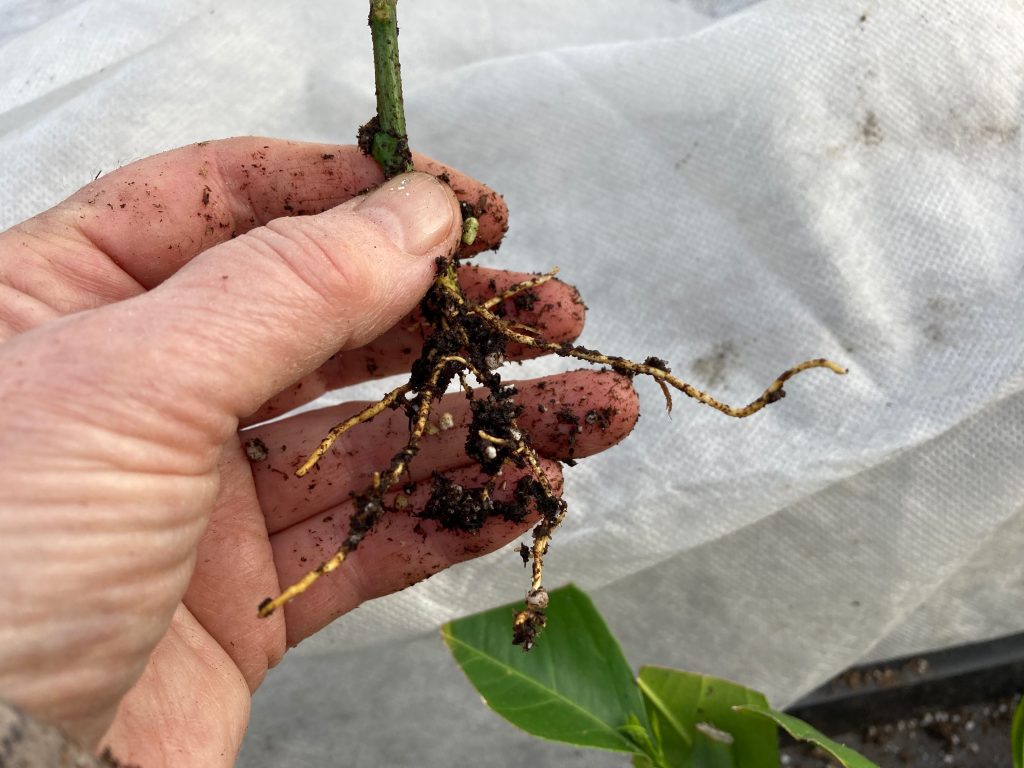
When I found out how easy it was to make Lemon cuttings from my old trees in the fall I was hooked. Now I usually take about 200 cuttings a year to root over winter in my greenhouse. This cutting has beautiful roots and is being moved up to a pot of its own in early spring.
Greenhouse Size
I’d already been a horticulturist for 30 years when I got my first greenhouse. And I thought I was ordering a really huge greenhouse because I ordered an 8′ by 12′ but – surprisingly – I filled it up immediately.
“Yeah, that’s that’s the common experience. We want to match [greenhouse] needs and make sure they really get what’s going to work for them.
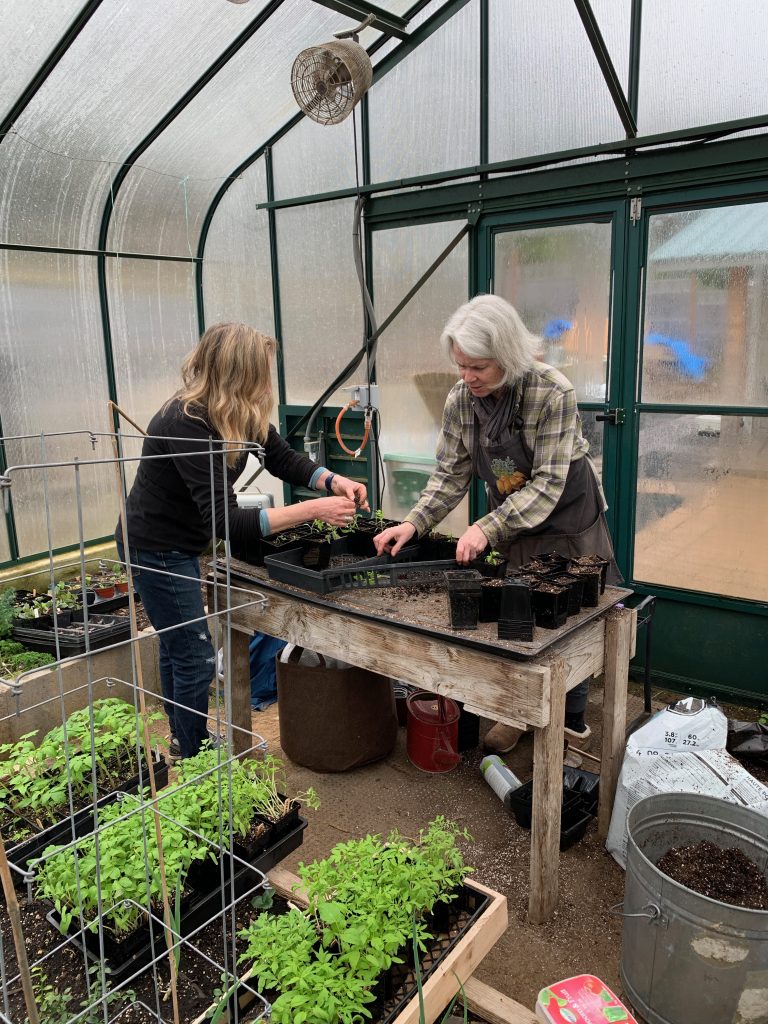
The bigger the greenhouse, the more room there is to work with friends in the warmth of your winter greenhouse. When the weather is cool outside and the wind is blowing, it is warm and cozy in the greenhouse.
You can make a greenhouse bigger down the road if you want to, but I’ve never had someone complain about having too much space in a greenhouse, not once.”
When we moved to a bigger lot we moved our small greenhouse with us but also bought a bigger one. I was hooked.
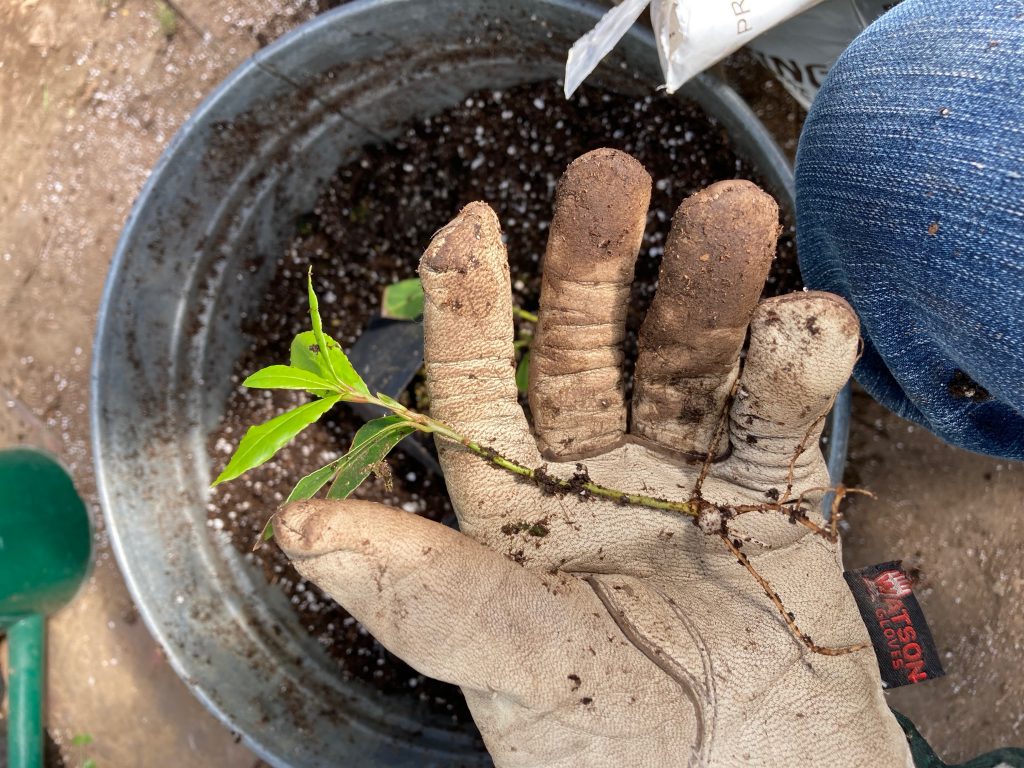
One of the unusual things I do in my greenhouse is start Bay Leaf cuttings so I can grow little trees for friends and family.
“Eight by 12 is really our most popular, you know, small residential size. [But] once we move up to a 12 foot wide greenhouse, it gives people an opportunity for a centre bench or a centre planter. And then you start getting, you know, more available space that way, or a multi-use idea. People say “”Hey, I want to sit in here and have a corner alcove created for a cup of coffee in the morning, or maybe a glass of wine in the afternoon, as well as growing space.””
I’ve seen in some of the brochures with fireplaces on an end wall, rugs in the middle, home offices. People can do anything in these greenhouses.
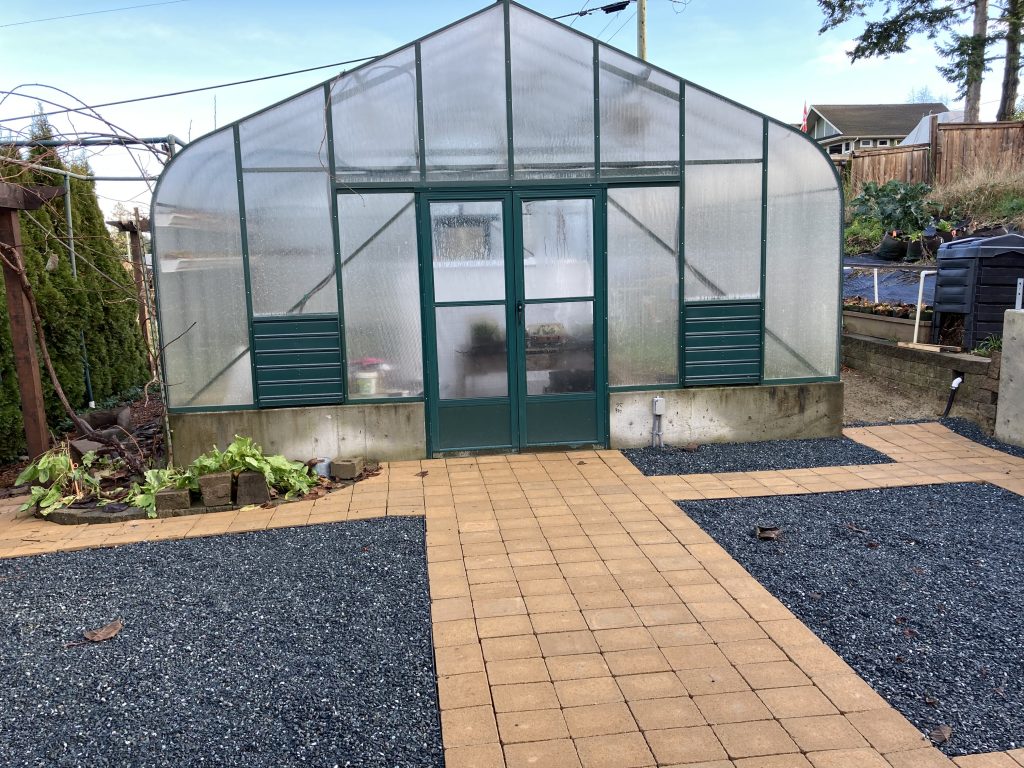
My newest greenhouse is 16′ x 20′ and last fall we added a patio so that eventually we can run classes at our greenhouse for everyone who wants to know how to grow better food for their friends and family.
“Yeah, absolutely. It’s so popular for that. Especially with our home attached greenhouses people will get either like a lean-to style, like a single slope off the side of the house. Very similar to like a sunroom or solarium. Or they’ll do one of our Gable style greenhouses and have it abutted to their home.
It’s fantastic. When you have a situation where you can walk straight out of the house, into the greenhouse and you use it as a growing and living space, it quickly becomes the most popular room in the house.”
So first step is, look around your yard, see if you’ve got a space. Closer to the house is always better.
“We can offer extra advice if people need an idea or suggestion,” but BCG can make any space work, from rooftop to attached to free-standing in the yard.
“In most cases, a person will give us like an idea of [their] plans. It’s actually become really common for us to do virtual site visits, where a person may have their iPhone or an iPad, or some kind of device out in their yard and be FaceTiming or Skyping with us.

Growing Meyer lemons is one way to use your greenhouse for food production. I harvest 125 lemons off my six-year old tree this year.
And we can have them point point around that so we can see, you know, see the yard see their situation. And so between that photographs and maybe some drawings we’ll come up with an idea or a concept and then we’ll return a drawing that more shows our greenhouse layer on [the yard], where we’re showing, you know, really what the bars are going to look like and how it’s going to fit.”
With a design-team in the shop it is possible to make most modifications, slopes, widths, lengths things like that. But there is also have a custom division that essentially stands up every greenhouse as it is manufactured. I saw a commercial greenhouse for a roof-top being designed this way and I was super impressed.
Individuals may choose a hip roof, a slope on all four sides, or vestibules or dormers coming off of sidewall. Different, interesting aesthetic ideas borrowed from the house are adapted to the greenhouse to make it a fully functional space to make any greenhouse really fit the clients.
BCG have done pyramid style greenhouses, cupolas, and other design aesthetics to match the house architecture.
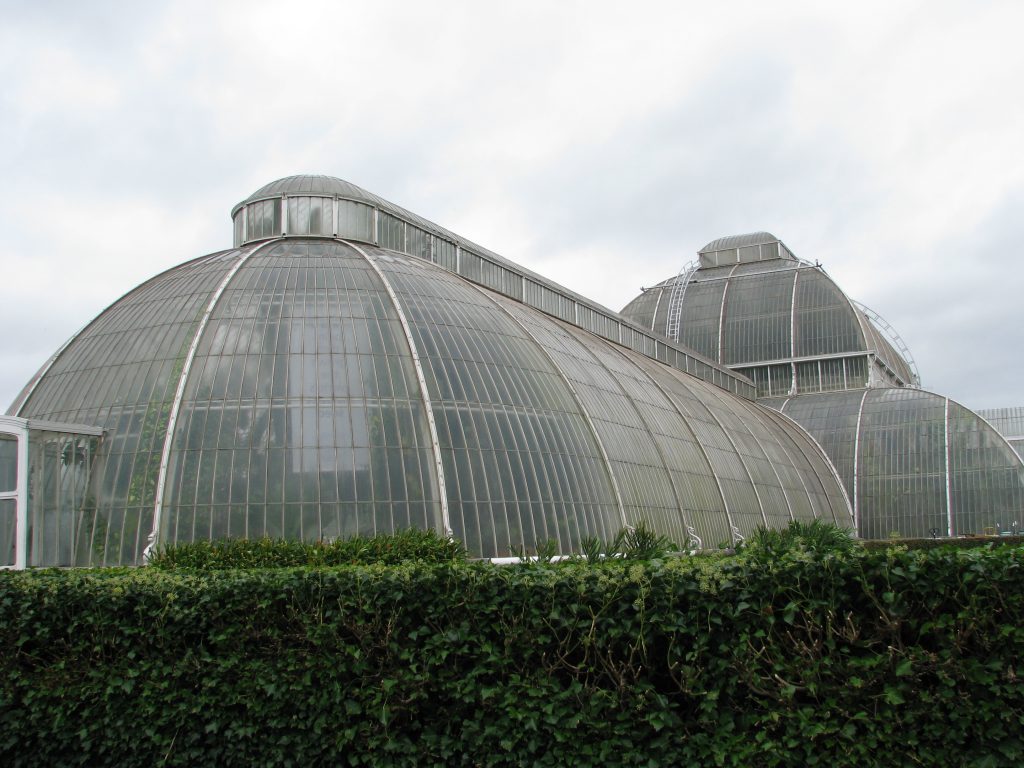
A display greenhouse such as this one at Kew Gardens in England is beautiful to look at and full of interesting details such as cuppolas (on the roof) and wing walls! You might need an estate to get away with building a design like this but if you have space, I am sure BC Greenhouse Builders can build it.
Foundations:
The greenhouse doesn’t actually come with a foundation but a very thorough foundation guide is included on the website. See details HERE.
Kyle likes pressure treated timbers or Cedar/Redwood, depending on where you’re located. That’s probably the easiest for a homeowner to do. “If they are going to build their own wood foundation our guide really just talks about the drainage that you want to have so that you don’t have moisture pooling around the timbers or, or pooling on the timber.
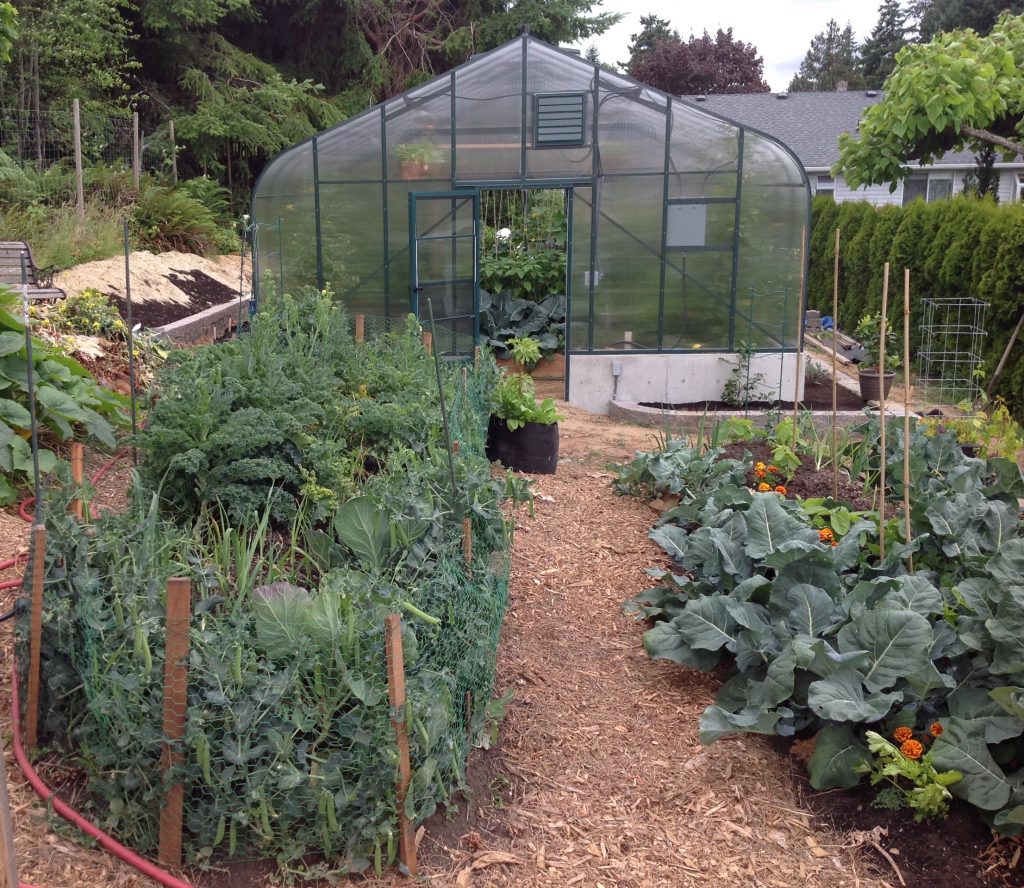
The foundation on our big greenhouse was poured from concrete with a door that drops so you can push a wheelbarrow right inside!
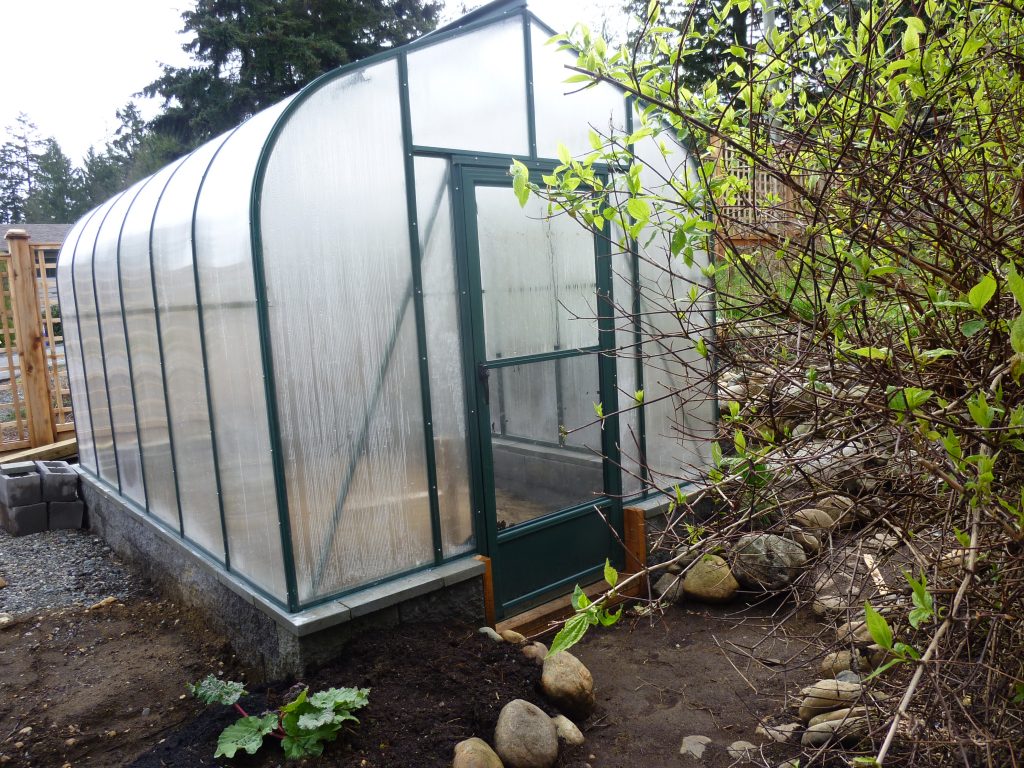
Our smaller greenhouse sits on concrete blocks for a foundation but still we used a dropped door system so it is easy to get in and out of the greenhouse.
If anyone ever comes to us and they have an inkling of doing concrete, either precast, cinder blocks, like you used, or a bit of a concrete wall, or even just a slab we’re all over that because the concrete is essentially permanent and, you know, it’s a lifetime product so a lifetime material like coconcrete means you have two things that are never going to be an issue.”
that’s fantastic. So, yeah. And the other detail that I did, it seems like so many little details. I didn’t realize. That if you build a higher foundation wall for your greenhouse, you can actually have the door dropped to accommodate that. And people are like, what does that mean? What’s a door. So instead of just walking straight into the greenhouse, I have one, a couple, I know that built it so that they walked down when they got to the greenhouse.
So they. Didn’t need a door drop, but generally, if you put a raised foundation all the way around, you have to step over something. You can’t bring a wheelbarrow in, but you guys make that easy. How do you do these door drops?
BCG makes it super easy to add a door drop so the roof of the greenhouse is taller with more available growing space. I have done this in both my greenhouses and I absolutely love that.
Solar greenhouses
Capturing the heat during the winter is important for some gardeners who want to maximize the growing season or use a lean-to style greenhouse to capture heat into the greenhouse or home. Kyle agrees and says that they want to set the client up for success. “We want to make sure we have the right heating capacity planned out for them.”
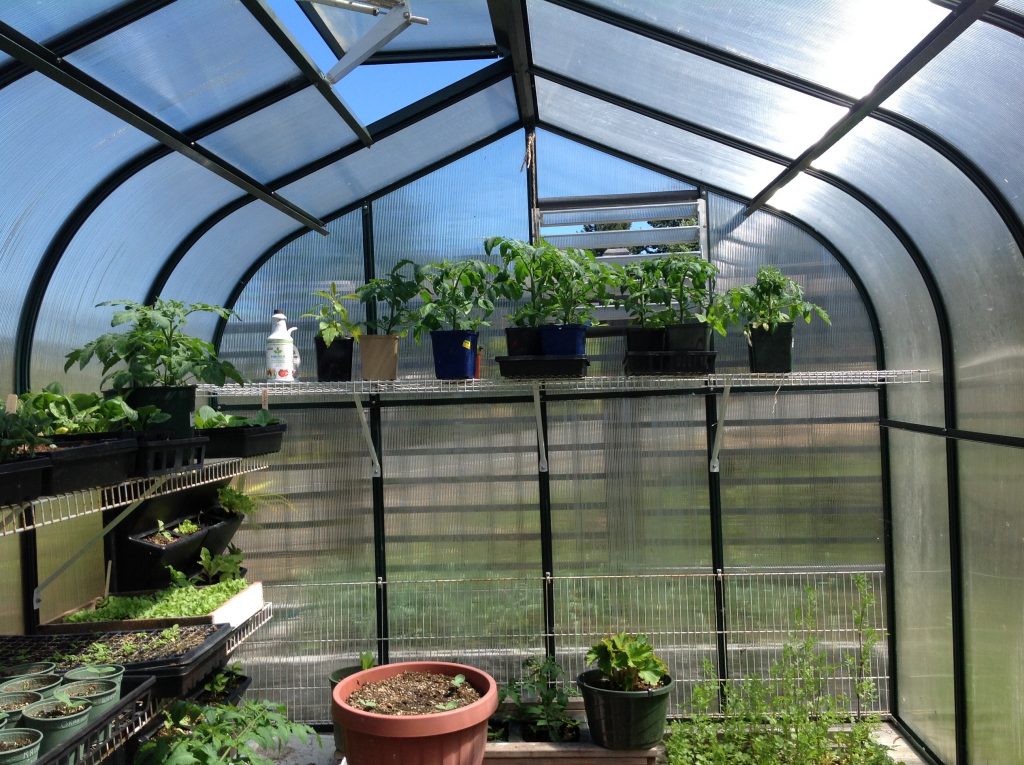
Polycarobonate is opaque so not as easy to see in or out.
For some clients, in the Midwest of the U S or in the Prairie provinces of of Canada where people really want to have the most efficient greenhouse, Kyle suggests a Walipini or pit-style greenhouse built into the ground or halfway into the ground or into a hillside.
“We definitely work right alongside customers with those designs. That would be one of my favorite things to do, and we have some of our technical sales people here that love working with clients, whether it’s adjusting the slope or the the glazing that we’re using.
A Walipini greenhouse is built into the ground. So basically you’re digging a bit of a pit into the ground or possibly it’s into a hillside. You’re digging into a hillside and then you’re only capping it with the greenhouse. Basically it’s a greenhouse cap. And so we help customers design that too. It’s a great way to utilize the earth for your energy and be more energy efficient.
“Maybe the sidewall is angled to match the sun angle for December 21st. So if you want to try and maximize how much light’s coming in, you want to maximize that solar heat gain. When we do that, we have different types of glazing that we’ll get into.
Glazing
There are choices to be made regarding the material used on the outside of the greenhouse and the material you choose is called the glazing. Kyle says that they provide both both glass, or multi-wall polycarbonate because both last a long time and are aesthetically pleasing. So the most common question is what’s the difference between glass and polycarbonate?
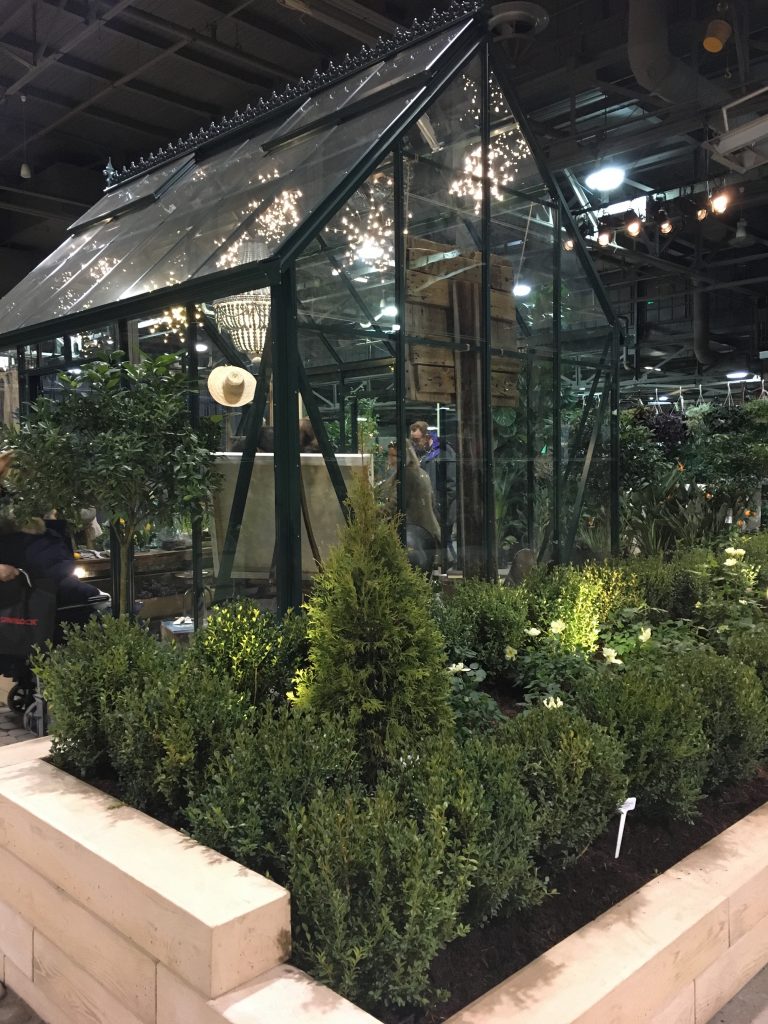
This glass-walled greenhouse was put up as part of a garden design for a landscape at Canada Blooms in Toronto. Glass is a truly beautiful way to glaze a greenhouse but may overheat or cool down quicker than the poly finishes.
Multi-walled polycarbonate looks like corrugated cardboard and that it has a solid face on both sides and there’s little channels or flutes that run up and down. “That’s your airspace that makes it more energy efficient. It is a clear material. So if you held your hand directly behind it and were looking at it, you could see your hand clear as day, but because it has those flutes it does distort the view. So you don’t get the same aesthetic as glass, and it will look a bit opaque. You wouldn’t be seeing things clearly from a distance or from an angle.”
I find this opaqueness a benefit because my greenhouse isn’t always as clean and tidy as it should be but from the road no one knows this. They just see green behind the walls and it does insulate better than single pane glass and it diffuses the light. Kyle says that the big benefit of polycarbonate, is it’s probably easier to get better growing results than glass.

Polycarobonate is opaque so not as easy to see inside or outside. You can see the roof vents open in this view. They keep the greenhouse cool automatically.
“[Polycarbonate] won’t heat up as quickly in the morning because it diffuses the light and because it’s insulated. Also, it’s not going to cool off as quickly at nighttime. So it’s a much more moderating experience for your plants [and] is probably easier to garden in. Easier to get great results. The negatives of polycarbonate is that it won’t last forever.” (Kyle estimates it will last anywhere from a 10 to 25 years.)
“All of the glass we use is tempered safety glass. So it’s very, very hard to break. It’s easy to handle. And Most people choose glass because of the aesthetic.” (PS Kyle says there’s no issue with hail with our tempered safety glass so people don’t have to worry about that.)
Glass also looks beautiful, works really well for most people in most climates so it is going to function really well, but also look really nice. Glass is a great way to go but, Kyle warns, if anyone has an all glass greenhouse, you do need to add shade to it. Most plants would be perfectly happy with around 70% light transmission, says Kyle so using a 30% shade cloth in summer is ideal over glass.
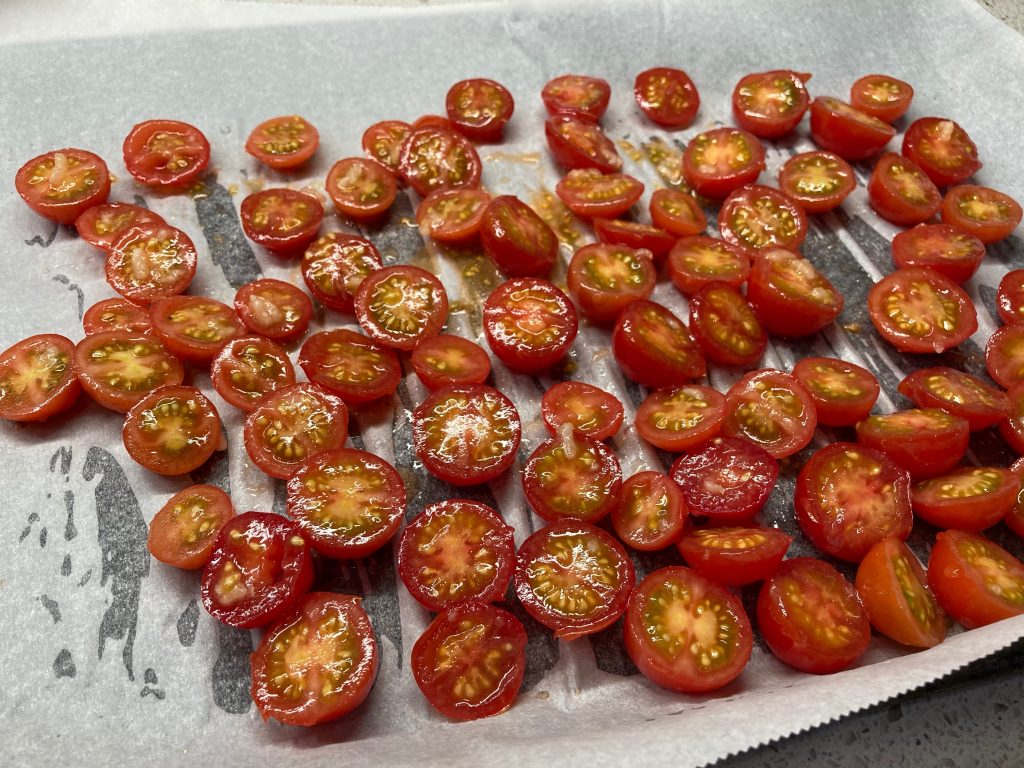
Roasting tomatoes during peak season allows luscious meals all winter.
Kyle says that they use high-performance glass that is commonly known as low E-Glass. It’s a low emissivity glass. And what it does is it reflects the far infrared and the infrared spectrum of light. And so if you’re adding heat to a greenhouse on the inside, it’s going to keep it reflected in.
“Alternatively, if you’re in a really hot climate it would also do the opposite. It’ll reflect that solar heat back away from that greenhouse in the middle of summer. So people with the really technical greenhouses use low-E glass on the roof of the greenhouse, but use clear glass on the vertical walls to maximize the solar heat gain in the winter.
Heating and Cooling:
I am wondering if it is realistic for people to grow year round in the greenhouse, or is it too expensive to heat? Kyles agrees that people do it but basically it depends on the level of the hobby and where people are located.
“Lots of clients have our greenhouses in very cold climates, Northern parts of Canada and Midwest in the US. And they’ll opt for the best glazing they can get and they let us help them size up the right heating to keep their greenhouse at the temperature they need to have it at. And you know, it’s yeah, it’s costly for sure. But if that’s your passion and your hobby? I know with many orchid growers, the orchids become like their children and then, you know, they care for them.”
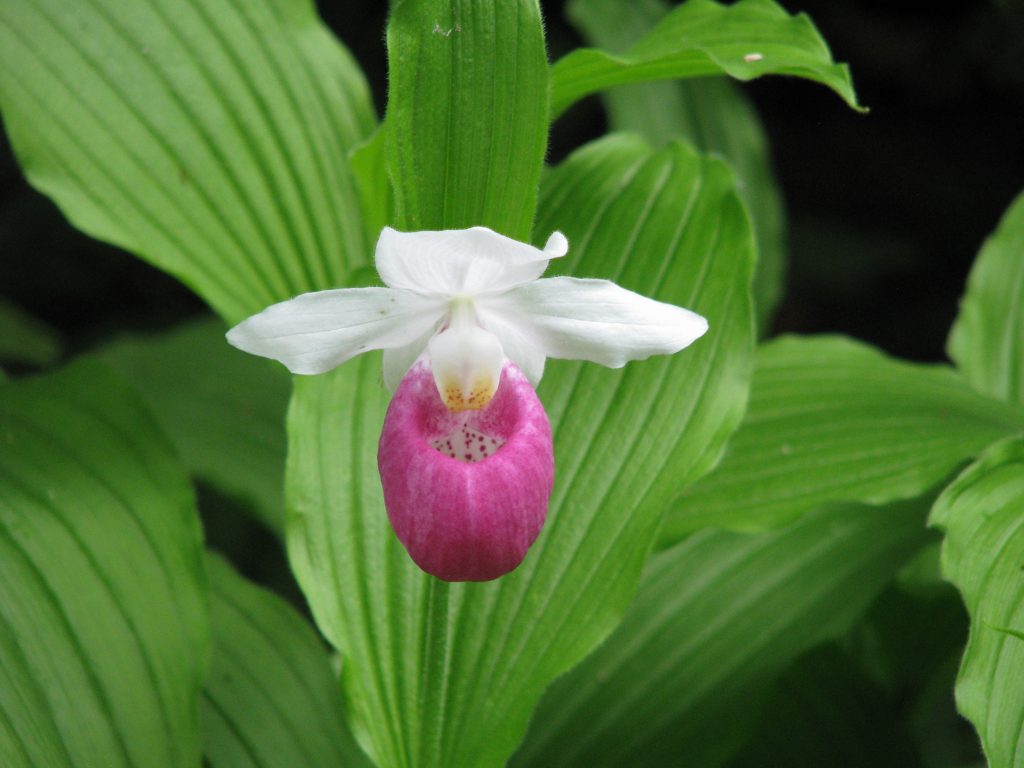
Growing orchids, lemons or winter vegetables are all different and valid ways to use your greenhouse.
But in most coastal climates, it’s really easy for people to keep a greenhouse above freezing. BCG recommends a little bit of extra heat in winter and most people aren’t going to be having tomatoes in January. They’ll opt for cool-climate plants like spinach,, mustard greens, arugula,
They’ll be switching up their harvest doing winter greens, herbs, winter vegetables through the winter months, and then for the spring and summer and fall months they’ll grow hothouse vegetables and all their flower gardening starts. “And I would say this it’s completely compatible to be wintering over your fuchsias and geraniums at the same time, as you know, growing your winter greens in a greenhouse. So you’re adding, you know, very little heat, keeping it above, freezing, not adding light and just watching things grow”
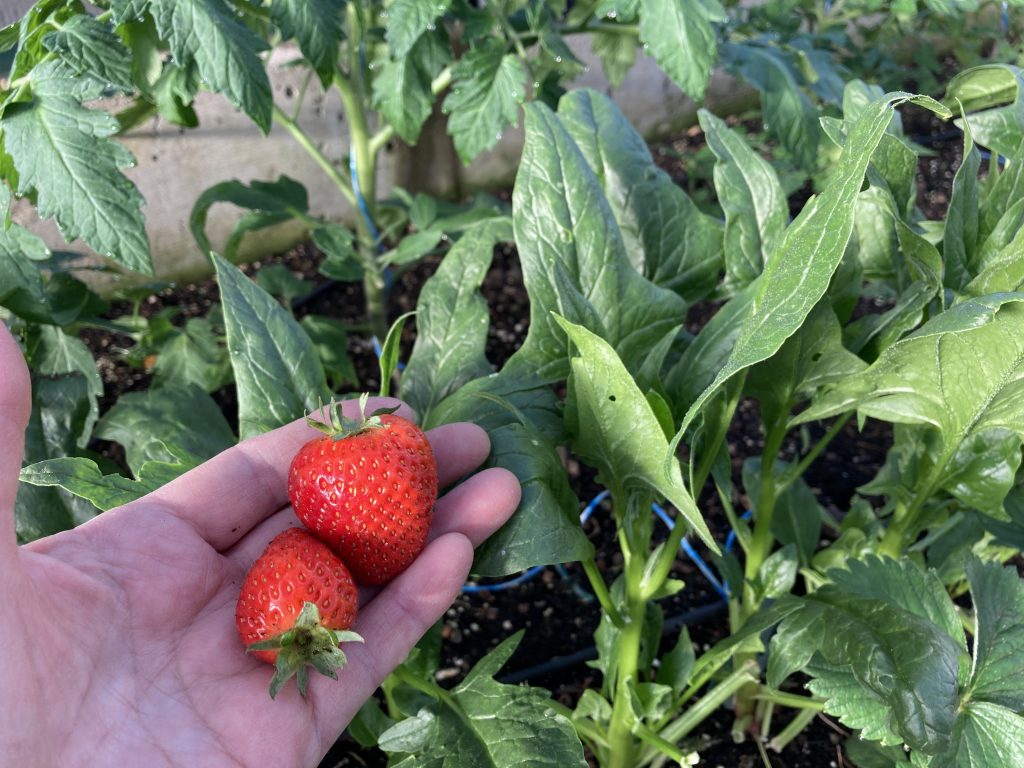
Hardy plants like spinach and strawberries tolerate a lot of frost in winter so are easy to grow indoors without spending a lot on heating the greenhouse.
If you keep your greenhouse in production Kyle suggests using a continuous circulating fan.
“Yeah, whenever I’m talking to a prospective client, I [always want to] tell them about the most important accessory in their greenhouse and that’s the circulating fan. And in our opinion, it should be going 24-7, as long as there’s plants in a greenhouse. So this is not the exhaust fan that’s built into your greenhouse wall. This is a circulating fan. It can be referred to as an HAF or horizontal airflow fan that might be mounted to one of the roof rafters or some of the infrastructure, or it can just be a, you know, a regular Lowe’s or home Depot circulating fan you pick up for household use.”
Having one or two fans in a greenhouse just to keep the air churning is a good thing.
But the most important part of the circulating fan is to keep the air moving. For plant health, you’re not going to have as many disease issues if the air is moving: you won’t get the algae and moss growing on the top layer of your soil. It is going to minimize condensation and it helps with heating in winter. Heat rises, and especially if you have a heater going, all the heat is going to be going up to the roof.
Just imagine how hot it is going to be up at the top to get the temperauture stable in the growing region closer to the bottom or on the bench?
“A circulating fan in winter time, aimed towards the roof just pushes all that hot air back down, moves it, circulates it around, and it reduces your heating cost, if you are heating. And even if you aren’t heating the greenhouse, it’s just going to move that pocket of heat and extend your season even more.”
Automatic Vents
Possibly one of my favourite features of the BC Greenhouse is that they always come with automatic vents, For anyone that’s gone away to work during the day and your greenhouse has been nice and cool in the morning and you come home and everything’s roasted, you’re really appreciating those automatic vents. These are not run by electricity or thermostat. They function all by themselves.
Kyle says that depending on the size of the greenhouse, the number of vents will vary, but every roof vent has an automatic opener. It looks like a bit of an elbow attached to both he roof vent and the greenhouse.
“And it’s operated with a cylinder that’s filled with wax. And so when the wax inside the cylinder heats up, it expands and pushes a little rod out of the cylinder. And as such it opens up the elbow, so the the vent will open up and the warm air [gets expelled].” The more the vents open up, the more air escape and as the greenhouse cools the wax cools and the vents autimatically close back down.
“And so I like to say that that’s really the ideal cooling for the greenhouse for fall, winter and spring, for sure. And in many cases, it may be all people need for summer [cooling] as well. Like you say, you go away, you don’t want to come home and have everything fried. So yeah, the automatic openers are ideal for that.”
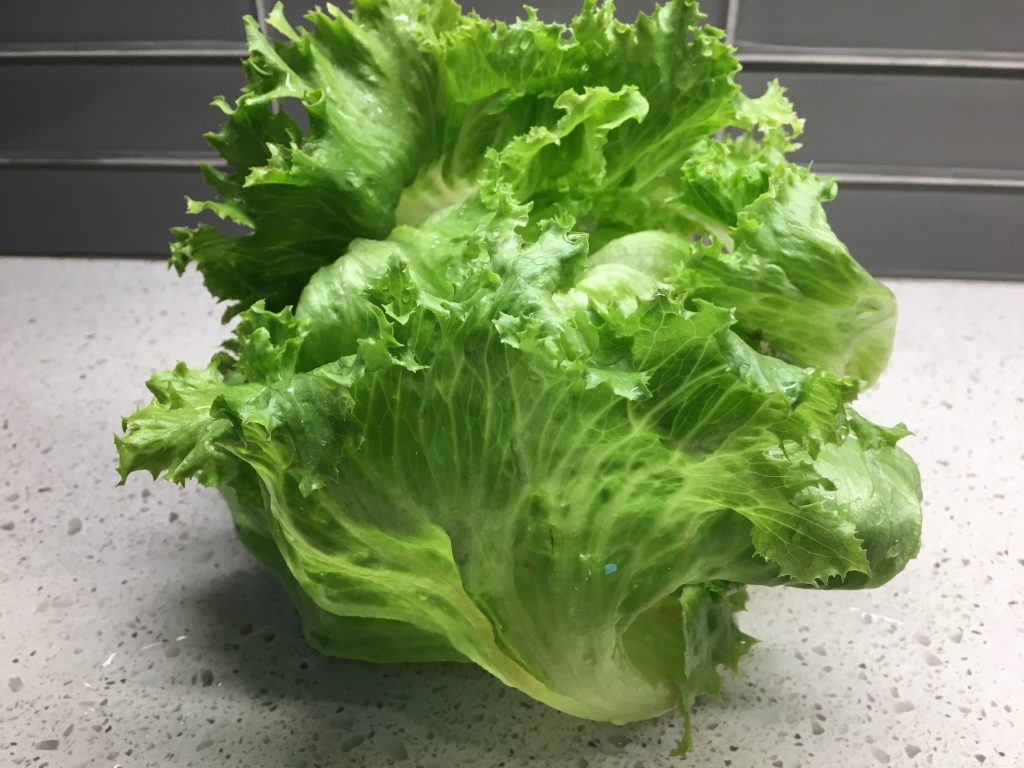
From lettuce to beans, my greenhouse lets me have amazing food year-round.
Without the vents as a greenhouse warms up in spring there are going to be days where it’s really cold outside. But sunny. Usually on the coldest days it is the sunniest. And if you’re just relying on a mechanical system, like an exhaust fan and an intake shutter to cool your greenhouse you may be surprised when the fan comes on and cold air rushes over your plant, killing them. Luckily with the automatic vents the greenhouse is self-cooling in the shoulder season.
I’ve been so impressed with that. I think that’s just another really great reason why the BC greenhouse builders greenhouses are so fantastic.
“[We] give the best advice we can in terms of setting up a greenhouse, planning out the heat, planning out the cooling. The greenhouse gives you the medium – it’s like the canvas, and then you just have to add a few little things [like] a small heater and cooling if the fans aren’t going to be enough, but we give advice on that.”
Where are these Greenhouses Available?
In closing the name BC greenhouse builders, is kind of confusing for people that aren’t living in BC. Are these greenhouses suited to other environments other than BC?
“Perfect question. Thanks so much for asking Donna. Yes, absolutely. We are fortunate we get to ship our greenhouses all over the world. We’re very excited about that people when they’re seeking out an upgraded or a stepped up greenhouse. They often come across us and we definitely want people to know that our greenhouses work and can be shipped anywhere.
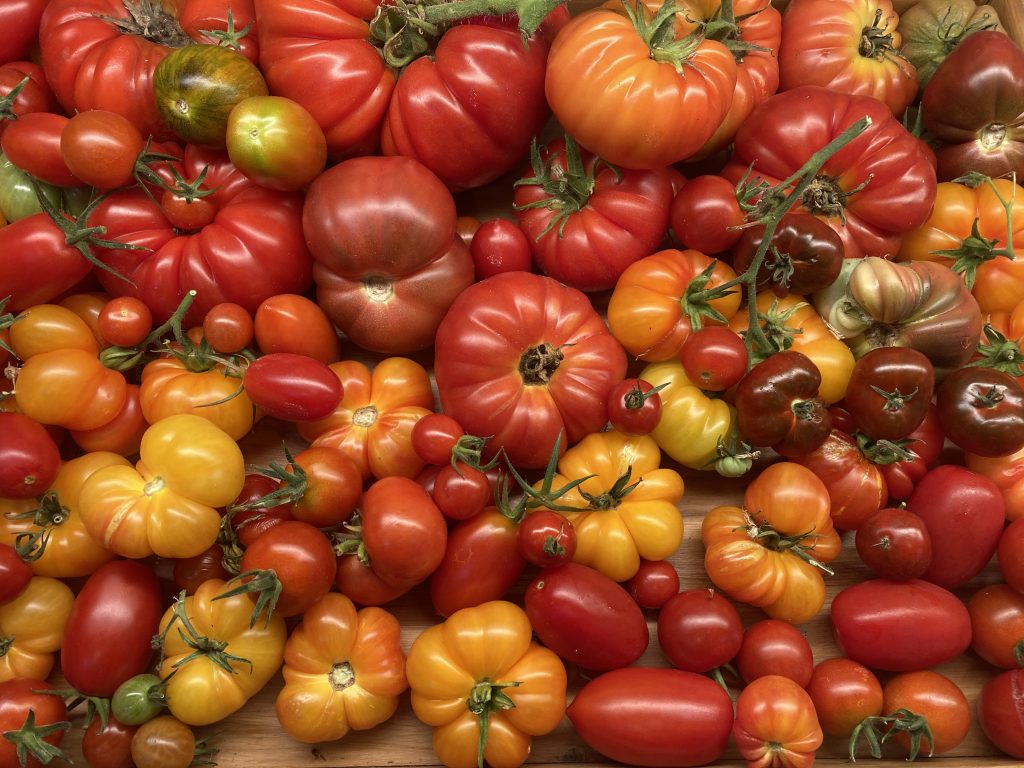
Tomatoes are a hothouse crop perfectly suited to a summer greenhouse.
We ship to Europe frequently of course, all across the U S and all across Canada. And South America, Australia, and Asia. We do ship greenhouses everywhere. They are really intended for people that are, you know, stepping up more of an enthusiast level where they want something that will be, better weather sealed and engineered for stronger winds, and stronger snow loads.
It’s not uncommon for us to ship our greenhouses down to the Gulf coast of the U S where they have to be hurricane rated. Or the North coast of BC or the Maritimes where the snow loads are going to be very extreme. Our greenhouses come with a base level of 85 mile per hour wind load rating and 30 pound per square foot snow load rating.
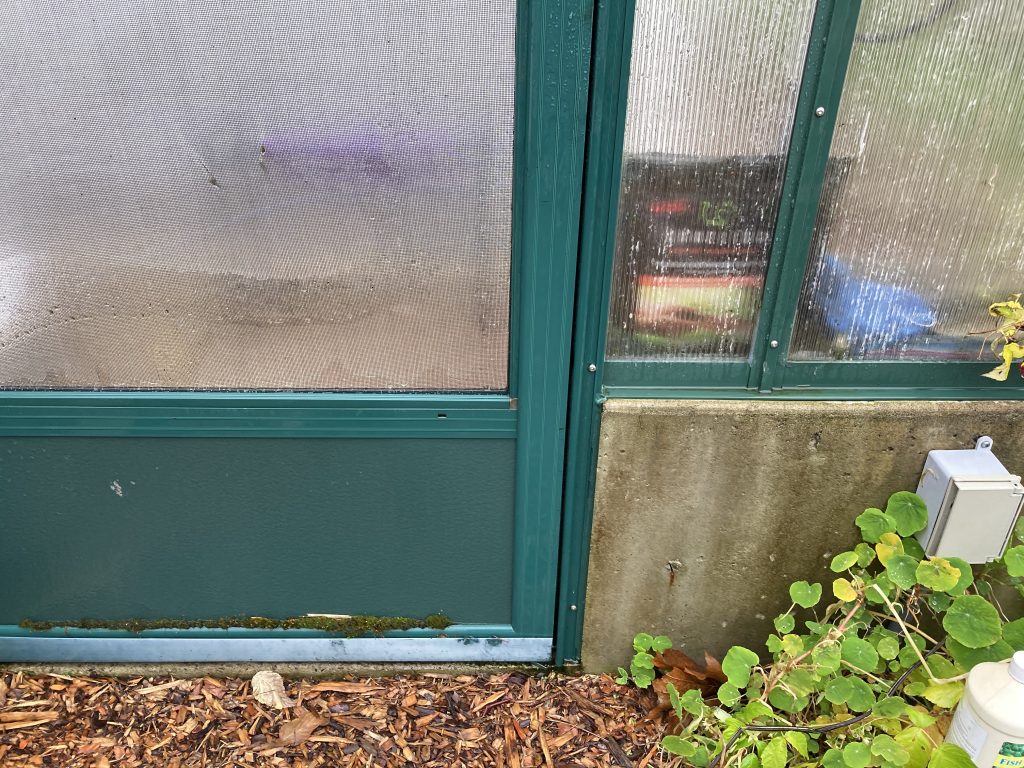
A close-up of the door-drop in my greenhouse.This might be the best feature in my Bc Greenhouse! Or at least one of them.
But for anyone that has more extreme conditions than that, I know we can have our greenhouses designed and engineered for people that need building permits. I think we’ve gone up to 120 or 130 pounds per square foot, snow load and 150 miles per hour wind. So they can be made very, very strong.”
The gardening gold this week is to personalize your greenhouse to work for you. Decide what you want to grow and what you want to spend, and then do it up right. If you want a solar greenhouse, or a Walipini then ask for help. Kyle says his designers are up for the challenge and they love doing quirky, fun designs for their clients.
What Would Donna Do?
Get my growing and gardening tips and pointers throughout the season.

















0 Comments